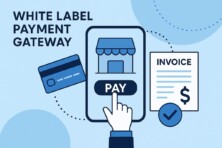Agentic payments and AI commerce are high on the paytech agenda today. Their potential is undoubtedly immense, but practical implementation, as always, relies on the tech stack functionality. As we see fintech giants delivering agentic payment protocols en masse, let’s put them under scrutiny.

We can speak of agentic commerce when AI agents, the artificial intelligence software tools that act on your behalf, buy things for people autonomously, based on simple instructions.
To work safely and smoothly and move on from search to actual purchase, these agents need new payment rules: ways for stores, banks, and platforms to recognise, trust, and transact with an agent instead of a human pressing “buy.”
Several big tech and payments companies, including Google, Stripe, Visa, Mastercard, and PayPal, as well as numerous fintech startups, are building those rules right now. This article explains what those protocols are, why big players care, how they help an AI-driven economy, and how the main approaches compare.
Payment Protocol for Agentic Commerce in Plain Terms
Think of a payment protocol as a common language or a checklist that everyone uses when money changes hands. Today, the language rules are written for humans, whether they pay with cards or log in to the payment system for one-click checkouts. Agentic commerce adds a new actor to the stage, an AI agent, that differs from a human user but needs to perform the same actions on their behalf. Therefore, the whole checklist needs updates:
- The agent must prove it’s authorised by a real person (agent identity & attestation).
- The payment platform must record the user’s intent (so charges are valid and reversible if needed).
- Risk and fraud systems must be able to detect automated abuse without blocking legitimate agent activity.
- Merchants must be able to accept these payments without a huge engineering lift.
A protocol bundles the rules, data fields, and verification steps that make this possible, just like a rulebook everyone agrees to follow.
Agentic Payment Protocols on the Market: Timeline and Features
This year, we saw a real race among the world’s payment and tech leaders to introduce protocols supporting agentic payments. Let’s recall the main events:
April 2025
- PayPal introduced its move into agentic commerce with the launch of its Agent Toolkit and a remote Model Context Protocol (MCP) server. These tools let developers create AI-powered checkout and invoicing systems that connect directly to PayPal’s worldwide payments network.
- At the same time, Mastercard launched the Agent Pay solution, designed to scale agentic commerce by integrating “agentic tokens” and programmable payments, in collaboration with Microsoft and other leading AI platforms.
- Visa also presented a suite of AI-driven agentic commerce tools called Visa Intelligent Commerce, the platform and ecosystem that Visa has built to enable AI agents to transact securely on behalf of consumers.
September 2025
- Stripe announced the Agentic Commerce Protocol (ACP), co-developed with OpenAI, with early partner merchants including Shopify and Etsy for “Instant Checkout” within ChatGPT via AI agents.
- Google introduced its Agent Payments Protocol (AP2) described as an open protocol to enable payments initiated by AI agents in commerce. The protocol is structured to integrate with other standards such as the Model Context Protocol (MCP) and Agent2Agent (A2A) protocol.
- PayPal partnered with Google under a multiyear agreement that embeds PayPal’s branded checkout, Hyperwallet, and payout services across Google platforms and supports Google’s open-standard Agent Payments Protocol (AP2).
October 2025
- Visa unveiled the Trusted Agent Protocol, intending to provide a foundational framework for agentic commerce. Developed with Cloudflare and supported by partners like Adyen, Shopify, Stripe, and Microsoft, it aims to help merchants verify AI agents and distinguish legitimate automated purchases from malicious bots.
Why Are Big Tech and Payments Companies Racing to Build Agentic Payment Protocols?
Apart from the FOMO, there are three clear reasons why big tech and payment companies rush to get on the bus of agentic payments:
- New revenue & product opportunities. If agents can buy things for users, platforms can add new services (instant reordering, travel planning and booking, subscription management) and capture fees or payment volume.
- Protecting trust and safety. Agent payments are risky. Common payment security issues like unauthorised charges, scams, and fraud remain. Besides, adding another tech layer to the system brings more misuse risks. Big incumbents want standards that let agents act without undermining consumer protection or bank/issuer rules.
- Platform control and interoperability. Whoever defines the protocol sets the marketplace foundation: token formats, attestations, SDKs, etc. That influences which platforms, wallets, and merchants integrate smoothly and gives the software provider a strategic advantage.
Put simply, agents create demand for new basic payment building blocks, and big companies want to own them.
How These Protocols Support The AI-Driven Economy
While it is clear what Big Tech wants, let’s take a look at what the agentic payment protocols mean for merchants, payment processors, prospective customers, and every other participant of an emerging AI economy.
- Agent identity & consent: Protocols let an agent attach proof of authorisation to a payment, like a signed note that says “Alice asked AgentX to buy this.” This reduces disputes and chargebacks.
- Short-lived tokens: Instead of sending a full card number to an agent, protocols use temporary tokens tied to a single agent action in line with the latest payment security advancements, lowering fraud risk in the autonomous e-commerce environment.
- Intent-bound receipts: Payments will carry verifiable metadata (what was purchased, who authorised it, when), so audits and refunds are simpler.
- Adjusted fraud signals: Payment networks can update their risk models to detect malicious scripted behaviour while avoiding false positives for legitimate agents.
- Developer tooling: SDKs and guidelines make it easier for merchants to accept agent payments without building bespoke systems.
Together, all these and many other smaller agentic protocol features let agents buy safely and scalably, unlocking use cases from personal shopping assistants to automated business procurement.
How The Main Players Approach The Protocols — Simple Comparison
Below are the main styles of approach to agentic payment protocols publicly displayed by each tech company. Let’s leave the tech details for developers and focus on practical differences.
Google Puts Platform Integrations First, Emphasizing Openness And Contextual Intelligence
Google’s approach ties payments closely to agent context and attestation: the agent, the model, and the user intent are packaged together so merchants can see who asked for what. Google prefers open interoperability and platform integrations, aiming for broad ecosystem adoption.
Stripe Takes Developer-First Approach, Offering Streamlined, Productized Payment Flows
Stripe focuses on making it easy for platforms and developers to accept agent-initiated purchases. Their tools emphasise clear developer APIs, fraud signals adapted for agents, and turnkey flows so businesses can add agent payments quickly.
Visa Focuses on Network Strength and Empowering Merchants Through Seamless Tools
Visa brings its scale and network controls: SDKs, merchant toolkits, and network-level signals that help merchants verify trusted agents and connect to existing card rails. Visa’s angle is making sure the card ecosystem recognises and supports agent-backed transactions.
Mastercard Emphasizes Tokenization And Transaction Traceability
Mastercard emphasises strong provenance and token-based protections. Its frameworks focus on registering and verifying agents and issuing dynamic tokens so every agent action is traceable and reversible at the network level.
Paypal Prioritizes Account-Based Trust And Reliable Payment Rails
PayPal leverages account-level protections and its existing fraud stack. Its approach enables agents to act through familiar PayPal/Braintree account flows, offering a straightforward path for merchants who already accept PayPal.
Key Common Themes You’ll See Across All Protocols
Despite some differences, the main agentic protocols on the market also share similarities:
- Every solution builds agent identity and intent-binding into the payment flow.
- Most use short-lived tokens or cryptographic receipts to reduce risk.
- Fraud detection gets a makeover to handle automated behaviour.
- Developer friendliness matters, as adoption depends on how easy it is for merchants to integrate.
Final thoughts
Payment protocols for agentic commerce shape what AI agents can safely do for users. The companies building these protocols balance openness, developer experience, and the hard realities of fraud and regulation. For AI enthusiasts, understanding these building blocks helps design agents that are useful, trustworthy, and ready for real-world money flows.









